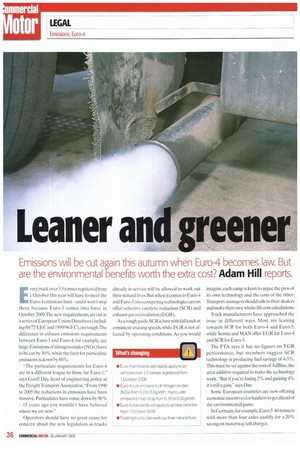Emissions will be cut again this autumn when Euro-4 becomes
Page 36

Page 37

If you've noticed an error in this article please click here to report it so we can fix it.
law. But are the environmental benefits worth the extra cost? Adam Hill reports.
Eery truck over 3.5 tonnes registered from 1 October this year will have to meet the Euro-4 emissions limit — and it won't stop there because Euro-5 comes into force in October 2009.The new requirements, set out in a series of European Union Directives (including 88/77/EEC and 1999/96/EC). are tough.The difference in exhaust emissions requirements between Euro-3 and Euro-4, for example. are huge. Emissions of nitrogen oxides ( NOx ) have to be cut by 30%, while the limit for particulate emissions is down by 80%.
The particulate requirements for Euro-4 are in a different league to those for Euro-1," says Geoff Day. head of engineering policy at the Freight Transport Association."From 1990 to 2005 the reductions in emissions have been massive. Particulates have come down by 96% — 15 years ago you wouldn't have believed where we are now."
Operators should have no great cause for concern about the new legislation as trucks already in service will be allowed to work out their natural lives. But when it comes to Euro-4 and Euro-5. two competing technologies are on offer: selective catalytic reduction (SCR) and exhaust gas recirculation (EGR).
Asa rough guide.SCR is best with full loads at consistent cruising speeds, while EGR is not affected by operating conditions. As you would
imagine, each camp is keen to argue the pros of its own technology and the cons of the other. Transport managers should talk to their dealers and make their own whole-life cost calculations.
Truck manufacturers have approached the issue in different ways. Most are leaning towards SCR for both Euro-4 and Euro-5, while Scania and MAN offer EGR for Euro-4 and SCR for Euro-5.
The FTA says it has no figures on EGR performance, but members suggest SCR technology is producing fuel savings of 4-5%. This must beset against the cost of AdBlue, the urea additive required to make the technology work. 'But if you're losing 2% and gaining 4% it's still a gain." says Day.
Some European countries are now offering economic incentives for hauliers to get ahead of the environmental game.
In Germany, for example,Euro-5 40-tonners with more than four axles qualify for a 20% saving on motorway toll charges. Yet despite the huge reductions in emissions that have been achieved, there are questions about the validity of the whole Euro emissions programme.
Frank Worsford from the University of Westminster's transport studies group says: "Truck manufacturers have achieved wonders producing cleaner, quieter, more fuel-efficient engines and full marks to them. The freight transport industry has done its bit, hut in the overall scheme of things it's tinkering at the edges." Figures support this view: in Britain. trucks only represent around 450,000 of the 31 million vehicles on the roads. "This is the argument we're using in London with the proposed low emissions zone," says Da We saYou're exempting 94% of vehicles on the road in London — do you really want to do that?' The fact is that trucks are easy targets."
No end to the Euro
They will remain w. b,..ca use the legislators simply want to cut emissions as far as possible. This means hauliers are unlikely to see the back of the Euro programme; Mercedes-Benz and Scania will both have Euro-5 engines in their line-ups before the end of the year— that's three years ahead of schedule.
But this process won't end there: looking past 2009, Euro-6 is alread■,, being discussed. to
































































































































































































